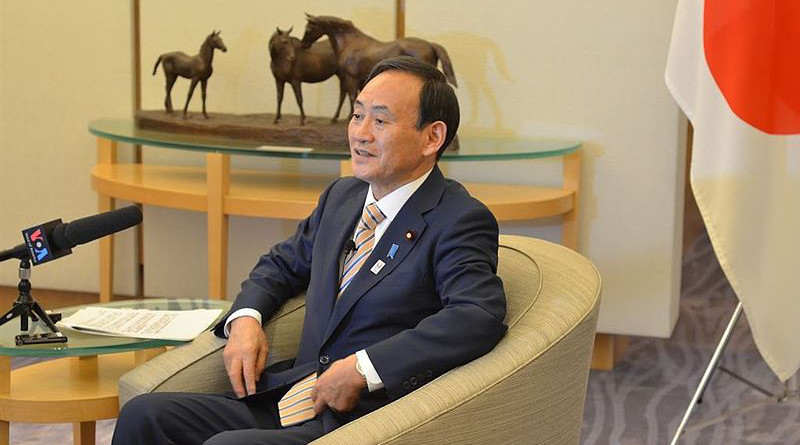New Japanese Prime Minister: Can Suga Emulate Abe’s Legacy And Bolster India-Japan Strategic Partnership? – Analysis
Japanese are overwhelmed by ethnocentric culture. They have a pride for their economic miracles without changing the business practices. Group culture supersedes individualism. Loyalty is core to company’s success. Seniority is the benchmark for promotion. Given these, the choice of Mr Yoshihido Suga as Prime Minister was not a surprise for Japanese, despite the fact that his stint in the Government was a Cabinet Secretary.
The new Prime Minister Mr Suga was the choice of LDP , the biggest political party in Japan which ruled Japan for longest period. He defeated his arch rivals Mr Kishide Fumio and Ishiba Singeru in a landslide victory. He was not a seasoned politician. His stint as Cabinet secretary qualifies him for a top bureaucrat. Nevertheless, his eight years loyalty as Cabinet Secretary to Prime Minister Shinzo Abe – the longest Prime Minister in Japan – might have polarized his choice as Prime Minister of Japan.
Most of the political experiences of Mr Suga are domestic, rather than in international field, even though he travelled widely with Mr Abe. He has low celebrity profile in international politics, unlike Mr Shinzo Abe. He was known ‘Shadow Prime Minister’ , but not the forthcoming Prime Minster . He does not have flashy image. He is less hawkish and more pragmatic. It is irony that he warned bureaucrats for failing to address COVID 19, albeit being a bureaucrat. This reflects his low ability for mustering vote bank – one of the important parameters to become political leader, in which Mr Shinzo Abe had excellence. Mr Shinzo Abe is known for his political acumen in influencing and mustering domestic and global support.
Backtracking on joining RCEP, incentivizing Japanese investors to decouple from China, launching FOIP mission (Free and Open Indo Pacific Region) to improve connectivity between Asia and Africa and ASEAN through freedom of navigation and free trade, asserting peace and stability in the Indo-Pacific, AAGC project initiative (Asia–Africa Growth Corridor) to improve trilateral economic relation between India, Africa and Japan, development of SCR ( Supply Chain Resilience) in Indo-Pacific region as an alternative to China, were the strides of Mr Abe’s international political outreach. In most cases, they unfolded Mr Abe’s challenges to contain China and propel up international backlash on overdependence on China for supply chain.
During Abe era, India–Japan relation was in the stream of new dynamism. There was a paradigm shift from mere bilateral economic relation to special strategic relation, including defence and global partnership. The relations extended to joint partnership for economic development in third countries and defence cooperation. Development of AAGR project, joint cooperation for development of Chabahar Port in Iran, strengthening of defence cooperation for national security with MOU in Defence cooperation were the cases of new dimension in political and economic relations towards global partnership and defence cooperation.
Observers believed , with the initiative of Abe administration twist emanated from 2+2 Foreign and Defence Ministerial meeting in November 2019. Japan was the second country, after USA, with which India had such dialogue format. The dialogue had an eye on countering China’s expansionism. Two sides provided opportunities to give strong spine to India- Japan special strategic and global partnership in the political security. Both sides were assertive on their respective roles for FOIP – the brain child of Mr Shinzo Abe .
Eventually, Japan’s about-turn to RCEP, on the close heel of India, was the reflection of India’s increasing significance to Japan, having a large stake in Indian Ocean – a major part of Indo-Pacific Region, which catalyzes FOIP – and Japan’s overarching Africa for better market accessibility with the help of India’s strong footprint in the continent. The rise of China was a big concern for India and Japan and that become vital for the two countries to come together, according to a Chinese Director.
“Any loss to China is a gain to India” became a new catchphrase. India poses challenge to become alternative destination for low cost manufacturing. According to a Deloitte survey in 2016, India would be the “New China” in low cost manufacturing countries in next five years. With China losing the powerhouse of low cost manufacturing competitiveness, five Asia Pacific nations would emerge the choice for low cost manufacturing destinations in place of China. They are Malaysia , Thailand, Indonesia, Vietnam and India. India would be the front-runner, the survey said.
JBIC (Japan Bank for International Cooperation) in its 31 survey for attractive investment destinations in November 2019, advocated India as the most attractive investment destination, leaving behind China and Vietnam at second and third positions respectively. The survey further revealed that India’s surge in the rank was due to a drop in voting rates in China. In other words, China’s drop in attractiveness paved the way for India to rise to the top for investment destination.
The strategic partnership led to a splurge in Japanese investment in India. Among the Asian countries, Japanese investment in India achieved highest growth in 2019. It grew by 53.2 percent, against 29.7 percent and 19.7 percent in Vietnam and China, respectively.
In summing up, India- Japan strategic partnership and engagement in defence cooperation demonstrate a major transformation in India-Japan relation from bilateral economy issues to political dynamism during Abe regime. Can Mr Suga accelerate the multi-faced India- Japan relation into a pragmatic global partnership?

